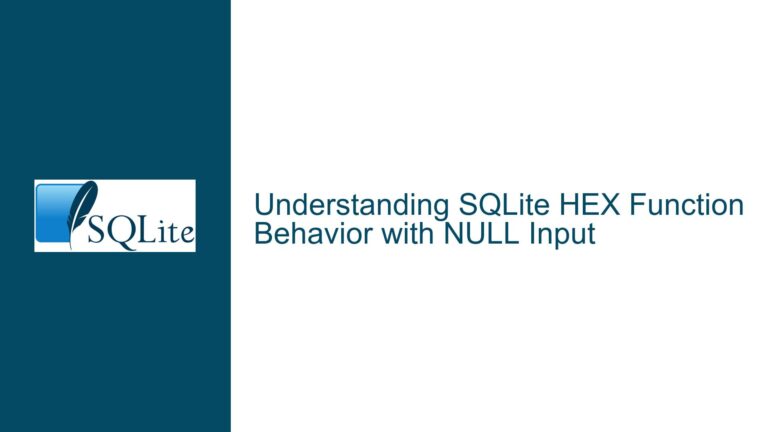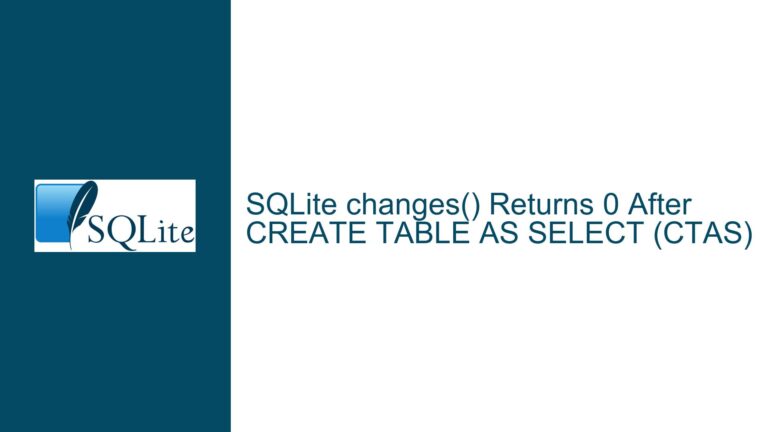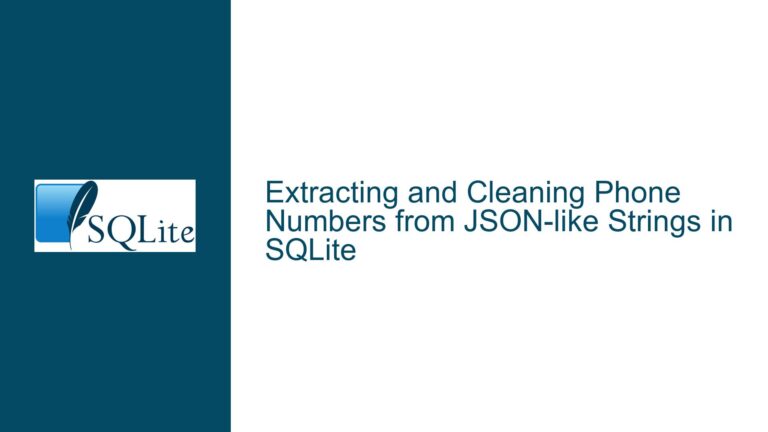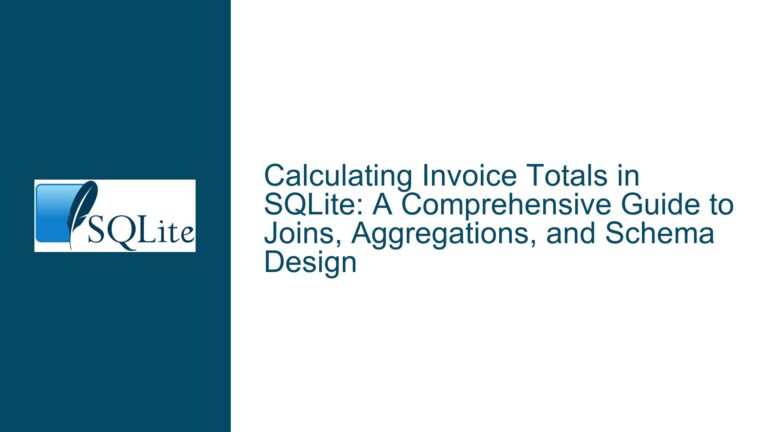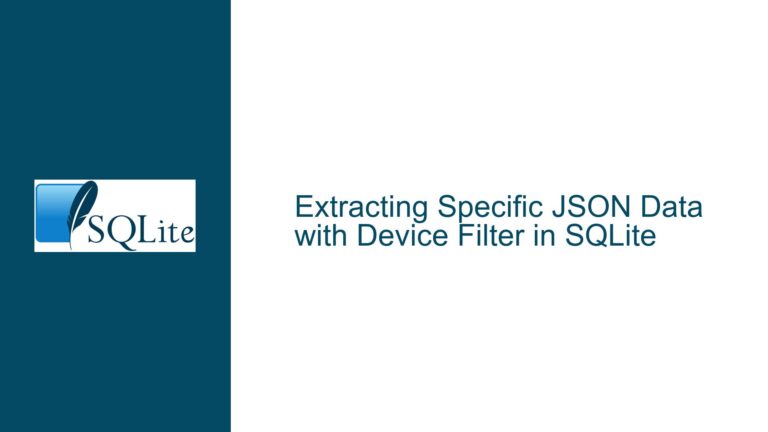Virtual Tables Cursor Prematurely Closed on Zero-Row Results
Virtual Table Cursor Behavior on Zero-Row Queries
When executing a query involving virtual tables in SQLite, a peculiar issue arises when the query returns zero rows. Specifically, the cursor is closed prematurely, preventing the calling code from accessing the schema of the result set via cursor.description. This behavior contrasts with standard SQLite tables, where the cursor remains open even when no rows are returned, allowing the schema to be retrieved. This discrepancy can lead to unexpected exceptions in applications that rely on the ability to inspect the schema of a query result, regardless of whether any rows are returned.
The issue manifests when joining two virtual tables that yield no rows. For example, consider two tables, tblA and tblB, implemented as virtual tables. A query joining these tables on a non-matching condition will return zero rows. In this scenario, the cursor is closed before the calling code can access cursor.description, resulting in an exception. However, if the same query is executed with standard SQLite tables, the cursor remains open, and the schema can be retrieved without issue.
A workaround exists by modifying the query to use a LEFT JOIN with a WHERE clause that ensures the join condition is not null. This approach prevents the cursor from being closed prematurely but comes at the cost of a potential performance hit due to changes in the query plan. This workaround highlights the sensitivity of virtual table behavior to query structure and underscores the need for a deeper understanding of how virtual tables interact with SQLite’s cursor management.
Interrupted Virtual Table Metadata Retrieval
The premature closure of the cursor in virtual table queries that return zero rows can be attributed to the way SQLite handles metadata retrieval for virtual tables. Unlike standard tables, virtual tables rely on custom implementations of the xBestIndex, xFilter, and xNext methods to provide data. When a query involving virtual tables returns no rows, SQLite may reset the cursor state before the calling code has a chance to access the schema information. This behavior is particularly evident when the query involves a join operation, as the join logic can influence the cursor’s lifecycle.
In the case of standard SQLite tables, the schema information is readily available because the table structure is statically defined within the database. The cursor remains open after a query execution, even if no rows are returned, allowing the calling code to inspect the schema via cursor.description. However, virtual tables do not have a static schema in the same sense. Instead, the schema is dynamically determined by the virtual table implementation, which may not be accessible once the cursor is reset.
The issue is further complicated by the interaction between SQLite’s VDBE (Virtual Database Engine) and the virtual table implementation. When a query is executed, SQLite generates a VDBE program that interacts with the virtual table methods to retrieve data. If the query returns no rows, the VDBE program completes execution, and the cursor is reset. At this point, the virtual table methods are no longer active, and any attempt to retrieve metadata from the cursor may fail. This behavior is consistent with SQLite’s design, which prioritizes efficiency and resource management. However, it can lead to unexpected issues when working with virtual tables, particularly in scenarios where schema inspection is required.
The premature cursor closure issue is not a bug in SQLite but rather a consequence of the way virtual tables are implemented and integrated into the SQLite engine. Virtual tables are designed to be lightweight and efficient, and their behavior is optimized for common use cases where schema inspection is not required after a query execution. However, this optimization can lead to challenges in scenarios where schema information is needed, regardless of whether any rows are returned.
Implementing Robust Virtual Table Queries with Schema Access
To address the issue of premature cursor closure in virtual table queries, developers can adopt several strategies to ensure that schema information remains accessible even when no rows are returned. These strategies involve modifying the query structure, adjusting the virtual table implementation, or using alternative approaches to retrieve schema information.
One effective strategy is to modify the query to ensure that the cursor remains open even when no rows are returned. This can be achieved by using a LEFT JOIN with a WHERE clause that ensures the join condition is not null. For example, the original query:
SELECT a.id, a.val1, a.val2, b.x, b.y
FROM tblA a
JOIN tblB b ON a.id = b.id
Can be modified to:
SELECT a.id, a.val1, a.val2, b.x, b.y
FROM tblA a
LEFT JOIN tblB b ON a.id = b.id
WHERE b.id IS NOT NULL
This modification changes the query plan, ensuring that the cursor remains open even if no rows are returned. However, this approach may introduce a performance overhead, as the query plan becomes more complex. Developers should carefully evaluate the trade-offs between performance and the need for schema access when adopting this strategy.
Another approach is to adjust the virtual table implementation to ensure that schema information remains accessible after the cursor is reset. This can be achieved by caching the schema information within the virtual table implementation and providing a method to retrieve it even after the cursor is closed. For example, the virtual table implementation could include a custom method that returns the schema information as a static structure, allowing the calling code to access it without relying on the cursor.
Developers can also use alternative methods to retrieve schema information without relying on cursor.description. For example, the PRAGMA table_info command can be used to retrieve schema information for standard SQLite tables. While this command does not work directly with virtual tables, developers can implement a similar mechanism within their virtual table implementation to provide schema information. This approach requires additional development effort but can provide a more robust solution for schema access in virtual table queries.
In addition to these strategies, developers should consider the broader context of their application and the specific requirements for schema access. In some cases, it may be possible to redesign the application to avoid the need for schema inspection after a query execution. For example, the schema information could be retrieved and cached before executing the query, eliminating the need to access it afterward. This approach can simplify the application logic and reduce the reliance on cursor behavior.
Finally, developers should be aware of the limitations and trade-offs associated with virtual tables in SQLite. While virtual tables provide a powerful mechanism for integrating custom data sources into SQLite, they also introduce additional complexity and potential challenges. By understanding the underlying behavior of virtual tables and adopting appropriate strategies, developers can mitigate issues such as premature cursor closure and ensure that their applications remain robust and reliable.
In conclusion, the premature closure of the cursor in virtual table queries that return zero rows is a nuanced issue that arises from the interaction between SQLite’s cursor management and virtual table implementation. By adopting strategies such as query modification, virtual table adjustment, and alternative schema retrieval methods, developers can address this issue and ensure that schema information remains accessible in all scenarios. Careful consideration of the trade-offs and application requirements is essential to implementing an effective solution.

